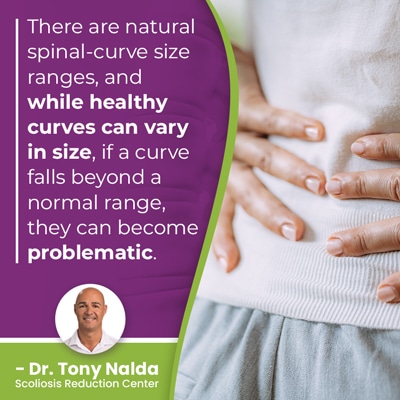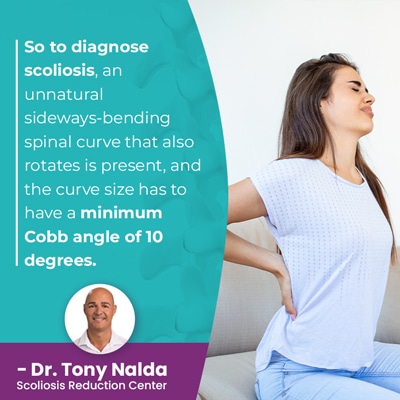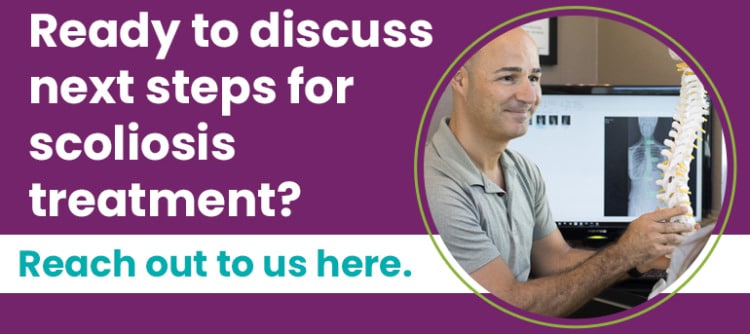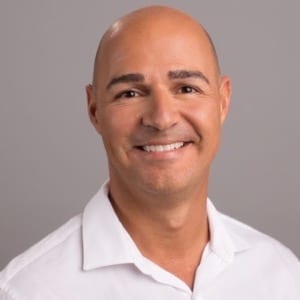Scoliosis Definition: What Is Spinal Curvature?

The spine helps us to stand upright, practice good posture, protects important organs, and works with the brain to form the central nervous system; this is why spinal conditions can cause such a wide range of symptoms felt throughout the body.
A healthy spine is curved at each of its main sections, and the spine's healthy curves make it stronger, more flexible, and better able to handle mechanical stress. There are healthy and unhealthy curves, and scoliosis is the development of an unnatural sideways-bending spinal curvature that also rotates.
As there are both healthy and unhealthy spinal curves, let's discuss the difference.
Table of Contents
Healthy Spinal Curves
A healthy spine will have a soft 'S' shape when viewed from the sides and will appear straight when viewed from the front and/or back.
A healthy spine is key to overall health; the spine gives the body structure, support, protects important organs, works with the brain as the central nervous system, allows us to stand upright, practice good posture, and engage in a wide range of movement.
There are three main spinal sections: the cervical spine (neck), thoracic spine (middle/upper back), and the lumbar spine (lower back).
As the spine is one long structure, the health of each section affects the other spinal sections.
Each spinal section has its own roles to play in preserving spinal function and biomechanics. The cervical spine has to support the weight of the head and the neck's range of motion. The thoracic spine is the largest spinal section and is the only section attached to the rib cage; it protects the lungs and heart, and allows for trunk movement. As the largest spinal section, the thoracic spine is vulnerable to a number of spinal conditions.
The lumbar spine is the lower back and has to support the weight of the spinal sections above, the trunk, and feels the effects of bending, lifting, and twisting motions.
Healthy spinal curves allow the spine to function optimally.
Lordosis and Kyphosis
Lordosis is a curvature type that bends inwards towards the center of the body, and this is a healthy cervical and lumbar curvature of the spine.
Kyphosis refers to a spinal curve that bends outwards, away from the body's center, and this curve type is found in the thoracic spine.
 There are natural spinal-curve size ranges, and while healthy curves can vary in size, if a curve falls beyond a normal range, they can become problematic.
There are natural spinal-curve size ranges, and while healthy curves can vary in size, if a curve falls beyond a normal range, they can become problematic.
A healthy range of cervical lordosis would fall between 20 and 40 degrees, and a healthy range of lumbar lordosis would fall within a range of 40 to 60 degrees, and a typical range of thoracic kyphosis would be 20 to 40 degrees.
If lordosis and/or kyphosis become over-pronounced, the curve size is excessive and problematic. If curve sizes are under-pronounced, this can also be problematic; a healthy spine is balanced, and this helps maintain a balanced and stable body overall.
Excessive lordosis and/or kyphosis can be referred to simply as lordosis and kyphosis or hyperlordosis and hyperkyphosis.
What is Scoliosis?
Scoliosis is a highly-prevalent spinal condition that affects approximately 7 million people in the United States alone.
While there are never treatment guarantees, there is a link between early detection, intervention, and treatment success.
As an abnormal lateral curvature of the spine that can get worse over time, scoliosis should always be taken seriously.
Scoliosis causes the spine to bend unnaturally to the side and rotate, and it's the rotational component that makes it a 3-dimensional condition.
 So to diagnose scoliosis, an unnatural sideways-bending spinal curve that also rotates is present, and the curve size has to have a minimum Cobb angle of 10 degrees.
So to diagnose scoliosis, an unnatural sideways-bending spinal curve that also rotates is present, and the curve size has to have a minimum Cobb angle of 10 degrees.
Cobb Angle
A patient's Cobb angle is a key piece of information that treatment is planned around, and condition severity is determined based on the measurement.
The more severe scoliosis is, the more noticeable its effects tend to be, and in children, the main effects are postural changes, and in adults, it's pain.
Children don't commonly find scoliosis painful because the condition doesn't become compressive until skeletal maturity has been reached.
A patient's Cobb angle is determined during X-ray by drawing lines from the tops and bottoms of the curve's most-tilted vertebrae, and the resulting angle is expressed in degrees.
The higher a patient's Cobb angle, the more severe the condition:
- Mild scoliosis: Cobb angle measurements of between 10 and 25 degrees
- Moderate scoliosis: Cobb angle measurement of between 25 and 40 degrees
- Severe scoliosis: Cobb angle measurement of 40+ degrees
- Very-severe scoliosis: Cobb angle measurement of 80+ degrees
Scoliosis curves are also progressive, meaning their nature is to get worse over time, and this means the size and rotation is increasing, as are the condition's effects.
There are different severity levels of scoliosis ranging from mild scoliosis to moderate scoliosis, severe and very severe scoliosis.
Dextroscoliosis versus Levoscoliosis
There are also different types of scoliosis with different curve types. Most cases of scoliosis are idiopathic scoliosis, meaning no known cause, and these cases are typical and classified as dextroscoliosis: when the scoliosis curve bends to the right, away from the heart.
Approximately 80 percent of known cases involve idiopathic scoliosis, and the most prevalent type overall is adolescent idiopathic scoliosis diagnosed between the ages of 10 and reaching skeletal maturity.
When I see a left-bending curvature of the spine, this is levoscoliosis and is atypical and associated with known causes: neuromuscular scoliosis, degenerative scoliosis, and congenital scoliosis.
With atypical cases like neuromuscular scoliosis, they can be particularly severe and progress quickly.
Neuromuscular scoliosis is caused by the presence of larger neurological or muscular disease like spina bifida, cerebral palsy, and muscular dystrophy.
Degenerative scoliosis is caused by natural age-related spinal degeneration so affects older people.
Congenital scoliosis is caused by a malformed spine that develops in utero so babies are born with the condition.
How to Treat an Unnatural Spinal Curvature
A single unhealthy spinal curve can affect the entire spine's biomechanics, and an unbalanced spine is unstable; this can affect the body in a number of ways.
Scoliosis that's left untreated can continue to progress, causing complications to develop such as breathing problems, cardiac and digestive issues.
There are two main ways to treat scoliosis: with surgical treatment, or with non-surgical treatment options.
Surgical treatment is invasive and costly and carries some serious potential risks, side effects, and complications. Spinal fusion surgery involves fusing the curve's most-tilted vertebrae into one solid bone and attaching metal rods to the spine to hold it in place.
While spinal fusion can straighten a bent spine, it can also cause spinal cord trauma, nerve damage, and can cause the spine to lose its flexibility and range of motion; fusing the spine goes against its natural movement-based design.
Spinal fusion surgery is commonly recommended to patients with severe, very severe, and/or atypical types of scoliosis that are likely to continue progressing.
Non-Surgical Treatment Options
There is, however, a conservative treatment approach with proven results that not only spares patients the hardships of invasive surgery, it's also less invasive and preserves as much of the spine's natural strength and function as possible.
Conservative treatment is offered here at the Scoliosis Reduction Center® and includes chiropractic care, physical therapy, scoliosis exercises, corrective bracing, and rehabilitation.
Chiropractic care is applied to reduce the scoliosis curve on a structural level, and physical therapy and scoliosis exercises work towards improving the spine's surrounding muscle strength and balance.
Corrective bracing is a valuable facet of childhood scoliosis treatment because growing spines are more malleable and responsive to bracing.
Rehabilitation can involve lifestyle guidance, continued chiropractic care, and custom-prescribed scoliosis exercises to help further heal and stabilize the spine from home.
Conclusion
There are a number of spinal conditions that cause a loss of healthy curves and alignment, but scoliosis has some characteristics that set it apart.
Scoliosis is a structural spinal condition that causes the spine to bend unnaturally to the side and twist, making it a 3-dimensional condition, and a minimum Cobb angle of 10 degrees is necessary to be considered a true scoliosis.
Scoliosis can be highly responsive to treatment, particularly with early diagnosis and intervention, and one of the goals of a conservative approach is to help patients avoid invasive surgical treatment that comes with risks.
Adolescent scoliosis is the most prevalent type and is also the most at risk for rapid-phase progression because of the rapid and unpredictable growth spurts of puberty.
A scoliosis diagnosis should always be taken seriously, and as a progressive condition, the best time to start treatment is always now.
Here at the Center, patients benefit from innovation and integration as multiple scoliosis-specific treatment disciplines are applied to impact conditions on every level.
Dr. Tony Nalda
DOCTOR OF CHIROPRACTIC
After receiving an undergraduate degree in psychology and his Doctorate of Chiropractic from Life University, Dr. Nalda settled in Celebration, Florida and proceeded to build one of Central Florida’s most successful chiropractic clinics.
His experience with patients suffering from scoliosis, and the confusion and frustration they faced, led him to seek a specialty in scoliosis care. In 2006 he completed his Intensive Care Certification from CLEAR Institute, a leading scoliosis educational and certification center.
About Dr. Tony Nalda
 Ready to explore scoliosis treatment? Contact Us Now
Ready to explore scoliosis treatment? Contact Us Now





